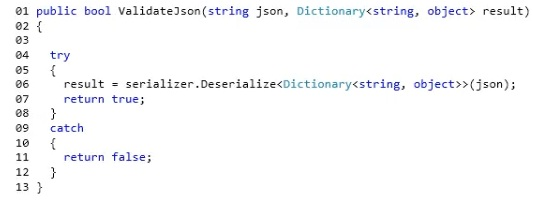READ Free Dumps For Microsoft- 70-483
| Question ID 17086 | You are creating a console application named Appl.
App1 retrieves data from the Internet by using JavaScript Object Notation (JSON).
You are developing the following code segment (line numbers are included for reference
only):

You need to ensure that the code validates the JSON string.
Which code should you insert at line 03?

|
| Option A | Option A
|
| Option B | Option B
|
| Option C | Option C
|
| Option D | Option D
|
| Correct Answer | B |
Explanation Explanation: JavaScriptSerializer().Deserialize Converts the specified JSON string to an object of type T. Example: string json = File.ReadAllText(Environment.CurrentDirectory + @"\JSON.txt"); Company company = new System.Web.Script.Serialization.JavaScriptSerializer().Deserialize
( Reference: C# - serialize object to JSON format using JavaScriptSerializer http://matijabozicevic.com/blog/csharp-net-development/csharp-serialize-object-to-json- format-using-javascriptserialization
| Question ID 17087 | You are creating a class library that will be used in a web application.
You need to ensure that the class library assembly is strongly named.
What should you do?
|
| Option A | Use the gacutil.exe command-line tool.
|
| Option B | Use the xsd.exe command-line tool.
|
| Option C | Use the aspnet_regiis.exe command-line tool.
|
| Option D | Use assembly attributes.
|
| Correct Answer | D |
Explanation Explanation: The Windows Software Development Kit (SDK) provides several ways to sign an assembly with a strong name: * Using the Assembly Linker (Al.exe) provided by the Windows SDK. * Using assembly attributes to insert the strong name information in your code. You can use either the AssemblyKeyFileAttribute or the AssemblyKeyNameAttribute, depending on where the key file to be used is located. * Using compiler options such /keyfile or /delaysign in C# and Visual Basic, or the /KEYFILE or /DELAYSIGN linker option in C++. (For information on delay signing, see Delay Signing an Assembly.) Note: * A strong name consists of the assembly's identityits simple text name, version number, and culture information (if provided)plus a public key and a digital signature. It is generated from an assembly file (the file that contains the assembly manifest, which in turn contains the names and hashes of all the files that make up the assembly), using the corresponding private key. Microsoft Visual Studio .NET and other development tools provided in the .NET Framework SDK can assign strong names to an assembly. Assemblies with the same strong name are expected to be identical.

